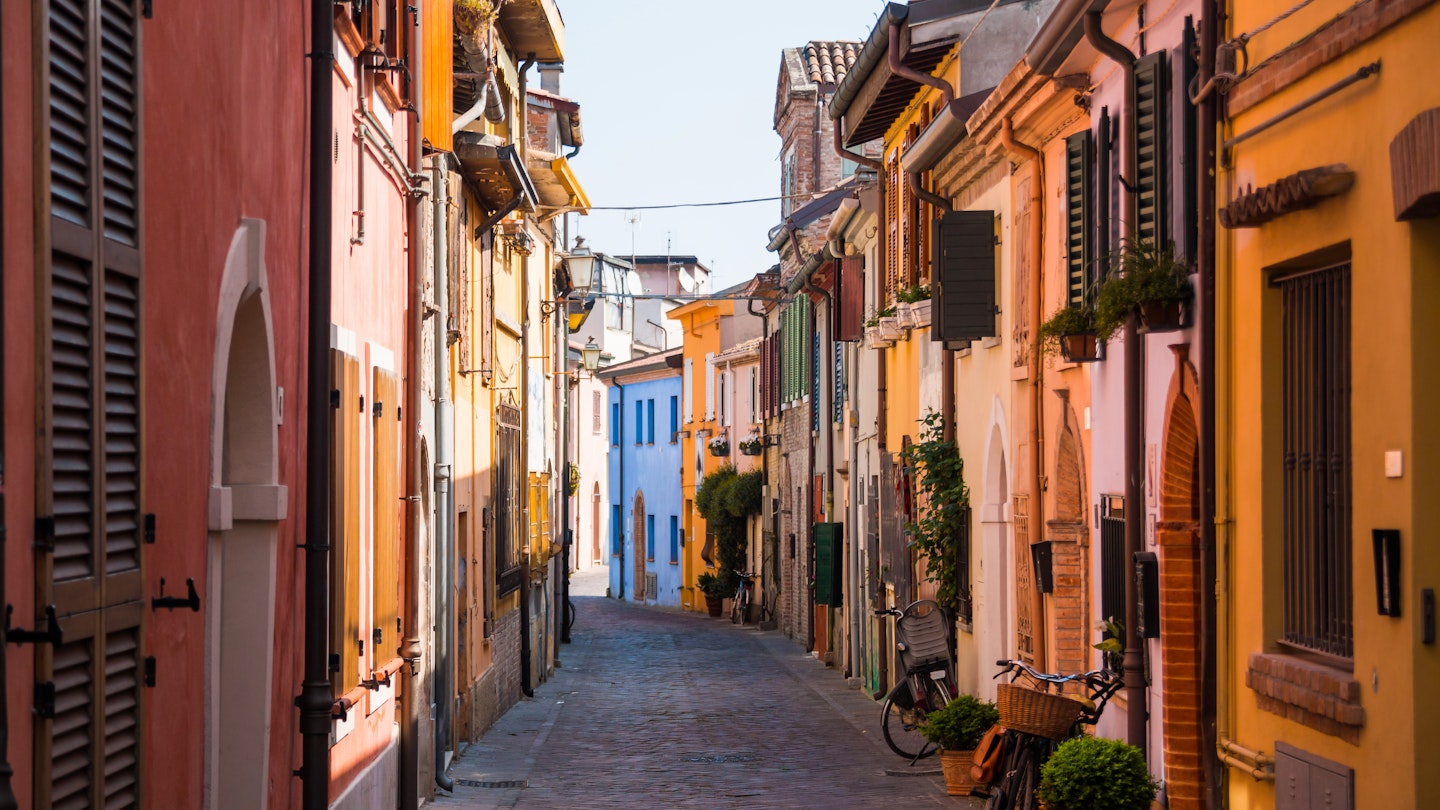Explore Historic Rimini, Italy
With its never-ending seafront, festive vibe, and wild nightlife, Rimini is one of Italy’s most beloved seaside resorts. It teems in summer as Italian holidaymakers and foreign sun-seekers dive into its gentle Adriatic waters and long sandy beaches.
However, venture back from the lungomare (seafront promenade), and you’ll discover it’s also a historic city filled with charming old town streets, ancient relics, Renaissance landmarks, and rich cultural gems.
Arco di Augusto
The Arco di Augusto, the oldest Roman arch in northern Italy, provides a monumental introduction to the centro storico (historic center). Built in 27 BC, this towering gateway marked the end of Via Flaminia, the consular road linking Rome with ancient Ariminum (Rimini). In the 10th century, battlements were added, yet elements of the arch’s original decor remain, including four carvings of Roman deities: Apollo and Jupiter on the outside; Neptune and Minerva on the city side.
Tempio Malatestiano
From the Arco, it’s a short walk to the Tempio Malatestiano, Rimini’s Renaissance cathedral. Designed by Leon Battista Alberti in 1450, this iconic landmark takes its name from Sigismondo Malatesta, the city’s 15th-century ruler who commissioned it to replace an earlier Gothic church.
Piazzas
Rimini’s compact old town is largely based on the layout of the ancient Roman city. The main thoroughfare, Corso d’Augusto, follows the ancient decumanus maximus Roman road. The central Piazza Tre Martiri, perched atop what was once the forum, features a statue of Julius Caesar, who is said to have addressed his legionnaires here in 49 BC. More recently, this square is named for three partisans executed here in 1944.
Further up the Corso, Piazza Cavour showcases an impressive duo of Gothic palazzi (mansions), a statue of Pope Paolo V, and a white marble fountain reputed to have impressed Leonardo da Vinci. An archway on its southern side leads to the Vecchia Pescheria, an 18th-century fish market now filled with vibrant bars and restaurants.
Teatro Amintore Galli
Facing Piazza Cavour is the Teatro Amintore Galli, Rimini’s historic theater that reopened 150 years after being damaged in WWII. Thanks to extensive restoration, its stunning neoclassical interior has been brought back to its original 19th-century glory, featuring Greek-Roman-style columns and a refined gold and ivory palette. Check its website for the latest programs in opera, classical music, drama, and dance.

Castel Sismondo
A stone’s throw from the Teatro, Castel Sismondo has been part of Rimini’s cityscape since the mid-15th century. This austere Renaissance castle, also known as the Rocca Malatestiana, served as the fortress-residence of military leader Sigismondo Malatesta. Today, it hosts cultural events while renovations are underway for a new museum dedicated to Rimini-born filmmaker Federico Fellini. When it reopens, visitors can expect immersive virtual recreations of Fellini’s legendary film sets within its echoing stone halls.
Biblioteca Civica Gambalunga
For a change of scenery, retreat to the tranquil halls of Italy’s oldest civic library. Established in 1619, this historic institution dates back to a generous benefactor, Alessandro Gambalunga, who bequeathed his collection of 1438 books to the municipality. Today, the library’s stock boasts around 325,000 volumes, including some of the oldest printed works in Italy and titles once prohibited by the Church. Guided visits, arranged in advance, take guests through centuries-old rooms on the first floor, where tomes are stored in dark walnut wood bookshelves.
Domus del Chirurgo
Books were not yet a concept when patients visited the Domus del Chirurgo for medical care. This 2nd-century Roman villa located under Piazza Ferrari belonged to a surgeon named Eutyches, who likely ran a day hospital from its main rooms. Among many discoveries made here is a remarkable collection of medical instruments, now displayed at the Museo della Città. Visitors at the villa can admire exquisite floor mosaics, including one depicting Orpheus surrounded by animals.
Cinema Fulgor
With its striking art-deco facade and sumptuous gold and scarlet interior, Cinema Fulgor is a Rimini institution. This is where Federico Fellini watched his first films and cultivated a passion for cinema. Aficionados can now follow in the maestro’s footsteps after the cinema reopened in January 2018, following a six-year renovation led by former Fellini collaborator and Oscar-winning production designer, Dante Ferretti. The cinema plays a central role in Rimini’s vision for a new Museo Internazionale Federico Fellini, and eventually, the upper floors will showcase exhibitions dedicated to the director.
Ponte di Tiberio
Road traffic has been crossing the Ponte di Tiberio since the 1st century AD, facilitating access to the historic center. In ancient times, this bridge marked the start of two Roman consular roads: Via Emilia, which connected to Piacenza in the Po river valley, and Via Popilia, leading to Ravenna and the northeast. For stunning views of the bridge’s five arches, wander down to the landscaped area on the bridge’s western side.
Borgo San Giuliano
Crossing the Ponte di Tiberio leads to the Borgo San Giuliano, one of Rimini’s most atmospheric neighborhoods. Now a trendy area of cobbled lanes, pastel-colored houses, wine bars, and popular trattorias, this quarter was once home to the fishing community of Rimini. Look for ceramic signs attached to various houses displaying the names and nicknames of the fishermen who once lived there. Additionally, many of the street murals pay homage to Fellini and his films.




